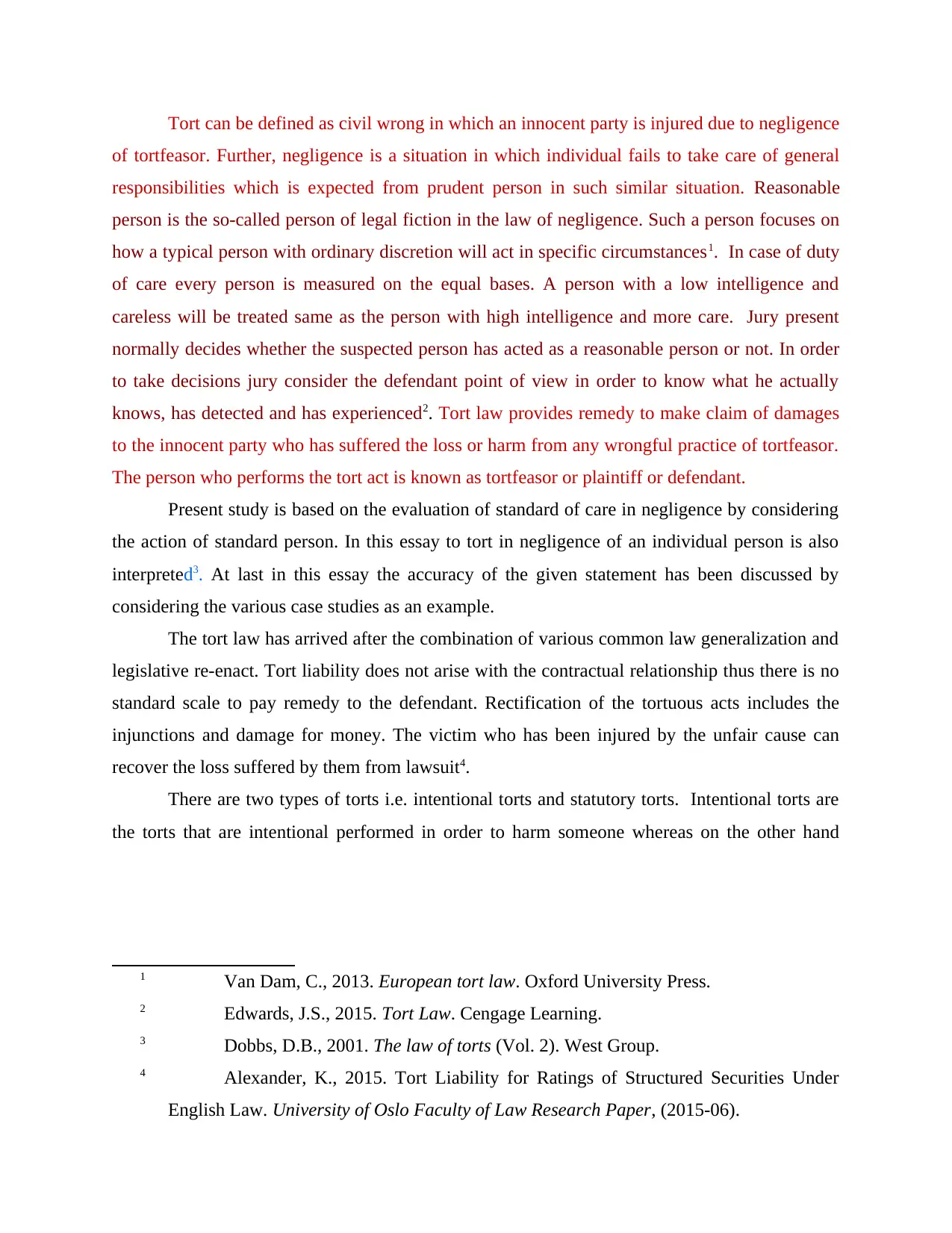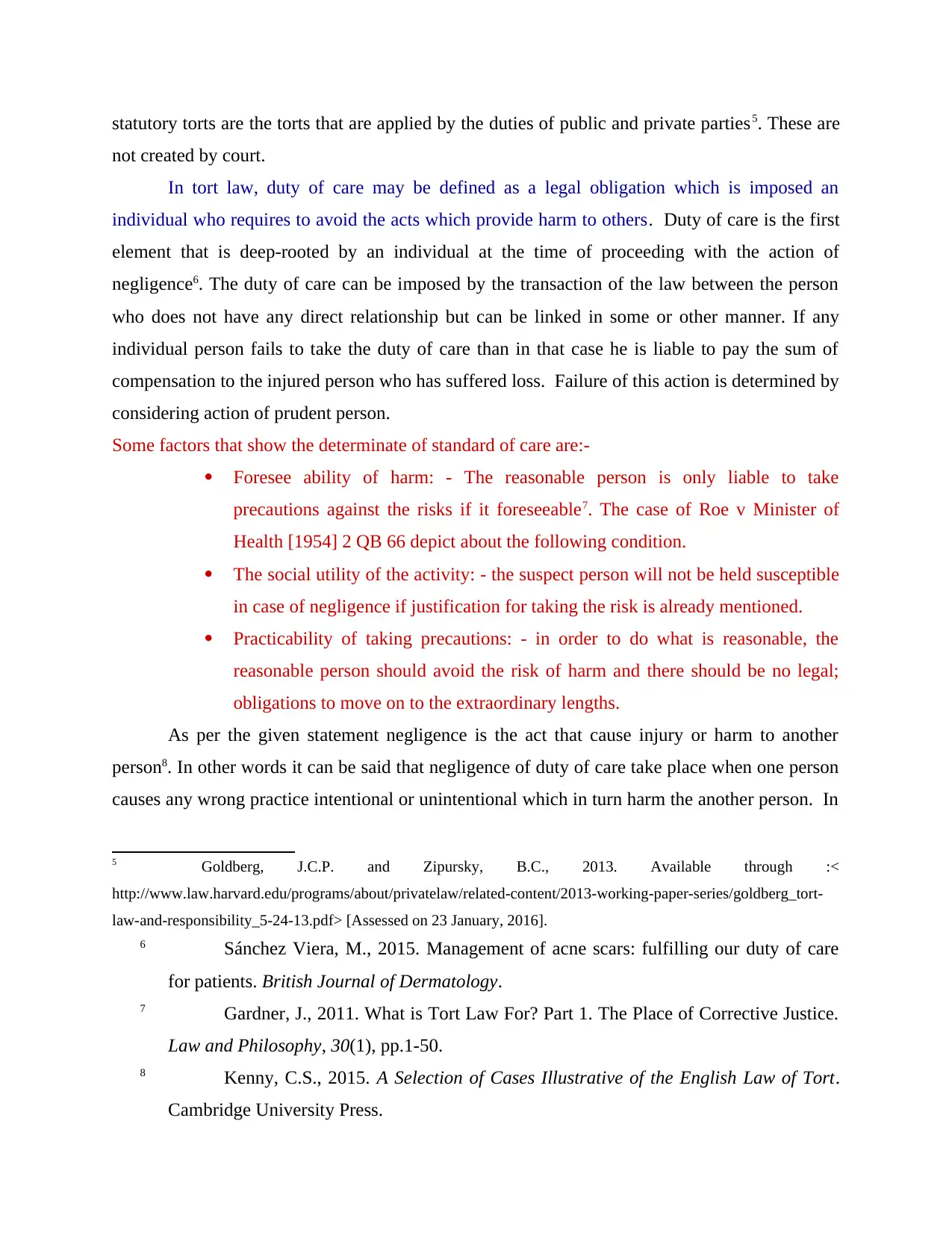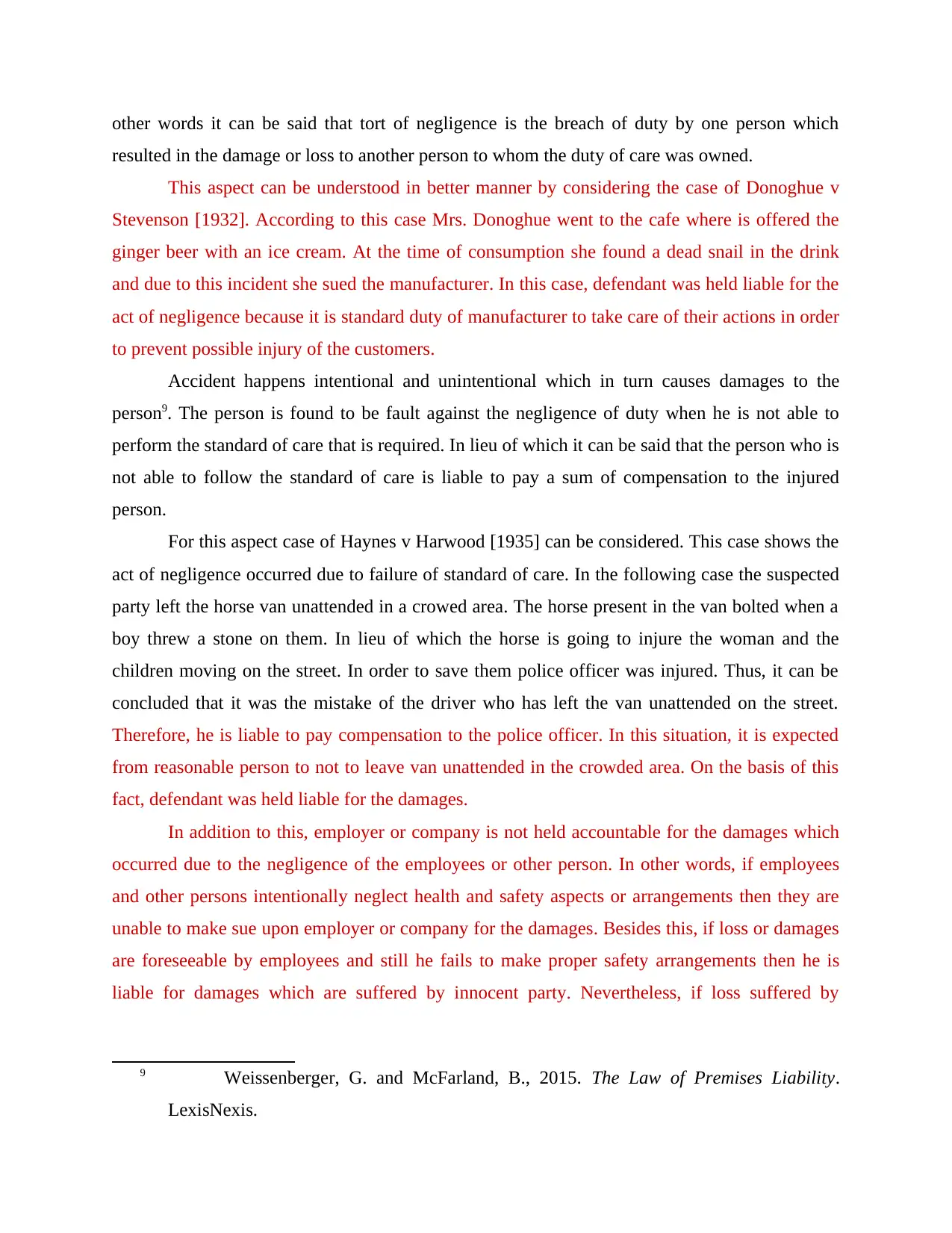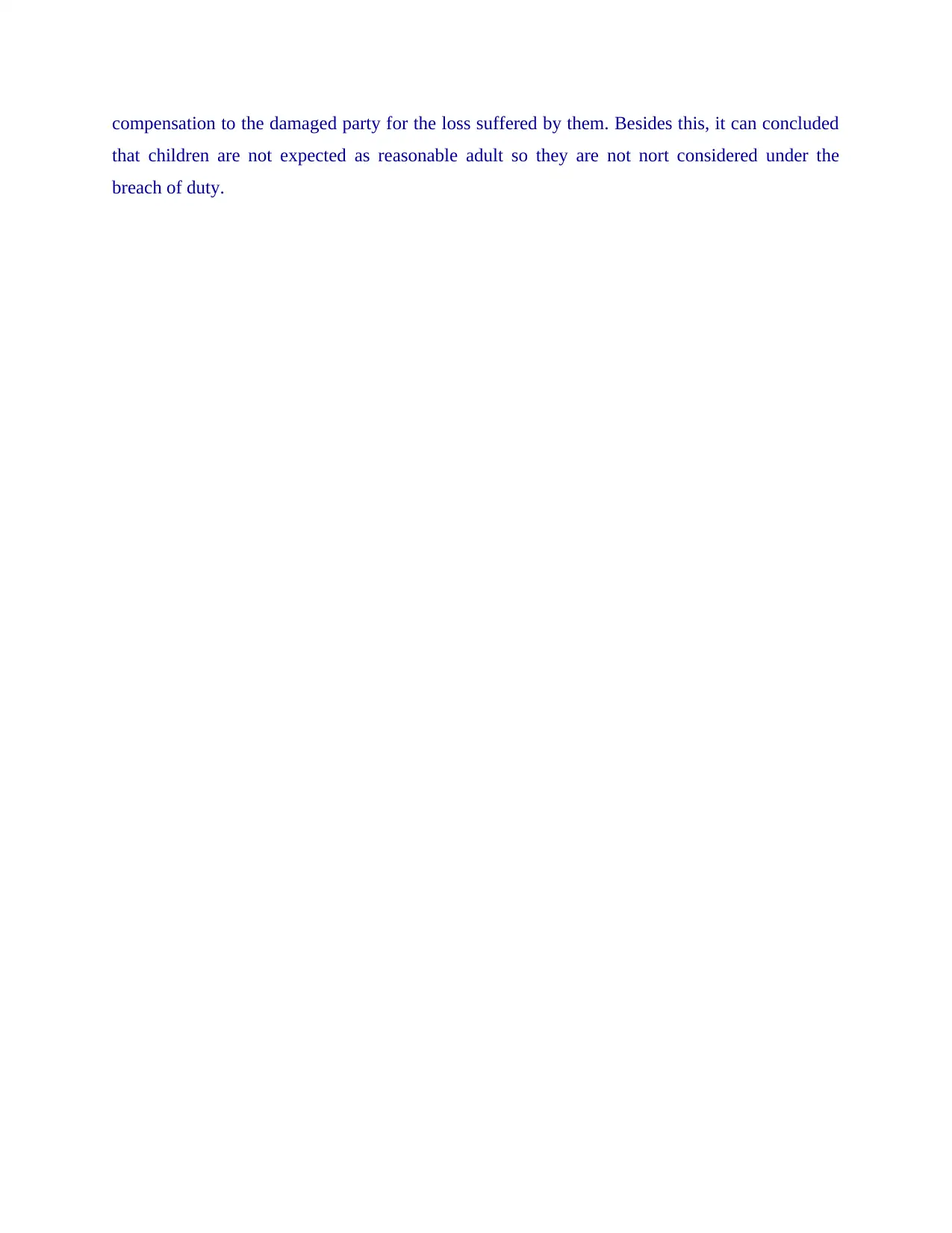An Analysis of Standard of Care in Negligence within Tort Law
VerifiedAdded on 2020/01/15
|6
|2052
|656
Essay
AI Summary
This essay provides a comprehensive overview of tort law, focusing on the concept of negligence and the standard of care. It defines torts, differentiating between intentional and statutory torts, and explores the duty of care as a legal obligation. The essay examines the 'reasonable person' standard, detailing how it's applied and factors considered by a jury. Key case studies, including Donoghue v Stevenson, Haynes v Harwood, and Bolton v Stone, are analyzed to illustrate the application of the standard of care in various scenarios. It discusses the liability of individuals, employers, and companies, considering foreseeability and the actions of employees or third parties. The essay concludes by affirming the importance of the reasonable person's duty of care in negligence cases.

TORT LAW
Paraphrase This Document
Need a fresh take? Get an instant paraphrase of this document with our AI Paraphraser

Tort can be defined as civil wrong in which an innocent party is injured due to negligence
of tortfeasor. Further, negligence is a situation in which individual fails to take care of general
responsibilities which is expected from prudent person in such similar situation. Reasonable
person is the so-called person of legal fiction in the law of negligence. Such a person focuses on
how a typical person with ordinary discretion will act in specific circumstances1. In case of duty
of care every person is measured on the equal bases. A person with a low intelligence and
careless will be treated same as the person with high intelligence and more care. Jury present
normally decides whether the suspected person has acted as a reasonable person or not. In order
to take decisions jury consider the defendant point of view in order to know what he actually
knows, has detected and has experienced2. Tort law provides remedy to make claim of damages
to the innocent party who has suffered the loss or harm from any wrongful practice of tortfeasor.
The person who performs the tort act is known as tortfeasor or plaintiff or defendant.
Present study is based on the evaluation of standard of care in negligence by considering
the action of standard person. In this essay to tort in negligence of an individual person is also
interpreted3. At last in this essay the accuracy of the given statement has been discussed by
considering the various case studies as an example.
The tort law has arrived after the combination of various common law generalization and
legislative re-enact. Tort liability does not arise with the contractual relationship thus there is no
standard scale to pay remedy to the defendant. Rectification of the tortuous acts includes the
injunctions and damage for money. The victim who has been injured by the unfair cause can
recover the loss suffered by them from lawsuit4.
There are two types of torts i.e. intentional torts and statutory torts. Intentional torts are
the torts that are intentional performed in order to harm someone whereas on the other hand
1 Van Dam, C., 2013. European tort law. Oxford University Press.
2 Edwards, J.S., 2015. Tort Law. Cengage Learning.
3 Dobbs, D.B., 2001. The law of torts (Vol. 2). West Group.
4 Alexander, K., 2015. Tort Liability for Ratings of Structured Securities Under
English Law. University of Oslo Faculty of Law Research Paper, (2015-06).
of tortfeasor. Further, negligence is a situation in which individual fails to take care of general
responsibilities which is expected from prudent person in such similar situation. Reasonable
person is the so-called person of legal fiction in the law of negligence. Such a person focuses on
how a typical person with ordinary discretion will act in specific circumstances1. In case of duty
of care every person is measured on the equal bases. A person with a low intelligence and
careless will be treated same as the person with high intelligence and more care. Jury present
normally decides whether the suspected person has acted as a reasonable person or not. In order
to take decisions jury consider the defendant point of view in order to know what he actually
knows, has detected and has experienced2. Tort law provides remedy to make claim of damages
to the innocent party who has suffered the loss or harm from any wrongful practice of tortfeasor.
The person who performs the tort act is known as tortfeasor or plaintiff or defendant.
Present study is based on the evaluation of standard of care in negligence by considering
the action of standard person. In this essay to tort in negligence of an individual person is also
interpreted3. At last in this essay the accuracy of the given statement has been discussed by
considering the various case studies as an example.
The tort law has arrived after the combination of various common law generalization and
legislative re-enact. Tort liability does not arise with the contractual relationship thus there is no
standard scale to pay remedy to the defendant. Rectification of the tortuous acts includes the
injunctions and damage for money. The victim who has been injured by the unfair cause can
recover the loss suffered by them from lawsuit4.
There are two types of torts i.e. intentional torts and statutory torts. Intentional torts are
the torts that are intentional performed in order to harm someone whereas on the other hand
1 Van Dam, C., 2013. European tort law. Oxford University Press.
2 Edwards, J.S., 2015. Tort Law. Cengage Learning.
3 Dobbs, D.B., 2001. The law of torts (Vol. 2). West Group.
4 Alexander, K., 2015. Tort Liability for Ratings of Structured Securities Under
English Law. University of Oslo Faculty of Law Research Paper, (2015-06).

statutory torts are the torts that are applied by the duties of public and private parties5. These are
not created by court.
In tort law, duty of care may be defined as a legal obligation which is imposed an
individual who requires to avoid the acts which provide harm to others. Duty of care is the first
element that is deep-rooted by an individual at the time of proceeding with the action of
negligence6. The duty of care can be imposed by the transaction of the law between the person
who does not have any direct relationship but can be linked in some or other manner. If any
individual person fails to take the duty of care than in that case he is liable to pay the sum of
compensation to the injured person who has suffered loss. Failure of this action is determined by
considering action of prudent person.
Some factors that show the determinate of standard of care are:-
Foresee ability of harm: - The reasonable person is only liable to take
precautions against the risks if it foreseeable7. The case of Roe v Minister of
Health [1954] 2 QB 66 depict about the following condition.
The social utility of the activity: - the suspect person will not be held susceptible
in case of negligence if justification for taking the risk is already mentioned.
Practicability of taking precautions: - in order to do what is reasonable, the
reasonable person should avoid the risk of harm and there should be no legal;
obligations to move on to the extraordinary lengths.
As per the given statement negligence is the act that cause injury or harm to another
person8. In other words it can be said that negligence of duty of care take place when one person
causes any wrong practice intentional or unintentional which in turn harm the another person. In
5 Goldberg, J.C.P. and Zipursky, B.C., 2013. Available through :<
http://www.law.harvard.edu/programs/about/privatelaw/related-content/2013-working-paper-series/goldberg_tort-
law-and-responsibility_5-24-13.pdf> [Assessed on 23 January, 2016].
6 Sánchez Viera, M., 2015. Management of acne scars: fulfilling our duty of care
for patients. British Journal of Dermatology.
7 Gardner, J., 2011. What is Tort Law For? Part 1. The Place of Corrective Justice.
Law and Philosophy, 30(1), pp.1-50.
8 Kenny, C.S., 2015. A Selection of Cases Illustrative of the English Law of Tort.
Cambridge University Press.
not created by court.
In tort law, duty of care may be defined as a legal obligation which is imposed an
individual who requires to avoid the acts which provide harm to others. Duty of care is the first
element that is deep-rooted by an individual at the time of proceeding with the action of
negligence6. The duty of care can be imposed by the transaction of the law between the person
who does not have any direct relationship but can be linked in some or other manner. If any
individual person fails to take the duty of care than in that case he is liable to pay the sum of
compensation to the injured person who has suffered loss. Failure of this action is determined by
considering action of prudent person.
Some factors that show the determinate of standard of care are:-
Foresee ability of harm: - The reasonable person is only liable to take
precautions against the risks if it foreseeable7. The case of Roe v Minister of
Health [1954] 2 QB 66 depict about the following condition.
The social utility of the activity: - the suspect person will not be held susceptible
in case of negligence if justification for taking the risk is already mentioned.
Practicability of taking precautions: - in order to do what is reasonable, the
reasonable person should avoid the risk of harm and there should be no legal;
obligations to move on to the extraordinary lengths.
As per the given statement negligence is the act that cause injury or harm to another
person8. In other words it can be said that negligence of duty of care take place when one person
causes any wrong practice intentional or unintentional which in turn harm the another person. In
5 Goldberg, J.C.P. and Zipursky, B.C., 2013. Available through :<
http://www.law.harvard.edu/programs/about/privatelaw/related-content/2013-working-paper-series/goldberg_tort-
law-and-responsibility_5-24-13.pdf> [Assessed on 23 January, 2016].
6 Sánchez Viera, M., 2015. Management of acne scars: fulfilling our duty of care
for patients. British Journal of Dermatology.
7 Gardner, J., 2011. What is Tort Law For? Part 1. The Place of Corrective Justice.
Law and Philosophy, 30(1), pp.1-50.
8 Kenny, C.S., 2015. A Selection of Cases Illustrative of the English Law of Tort.
Cambridge University Press.
⊘ This is a preview!⊘
Do you want full access?
Subscribe today to unlock all pages.

Trusted by 1+ million students worldwide

other words it can be said that tort of negligence is the breach of duty by one person which
resulted in the damage or loss to another person to whom the duty of care was owned.
This aspect can be understood in better manner by considering the case of Donoghue v
Stevenson [1932]. According to this case Mrs. Donoghue went to the cafe where is offered the
ginger beer with an ice cream. At the time of consumption she found a dead snail in the drink
and due to this incident she sued the manufacturer. In this case, defendant was held liable for the
act of negligence because it is standard duty of manufacturer to take care of their actions in order
to prevent possible injury of the customers.
Accident happens intentional and unintentional which in turn causes damages to the
person9. The person is found to be fault against the negligence of duty when he is not able to
perform the standard of care that is required. In lieu of which it can be said that the person who is
not able to follow the standard of care is liable to pay a sum of compensation to the injured
person.
For this aspect case of Haynes v Harwood [1935] can be considered. This case shows the
act of negligence occurred due to failure of standard of care. In the following case the suspected
party left the horse van unattended in a crowed area. The horse present in the van bolted when a
boy threw a stone on them. In lieu of which the horse is going to injure the woman and the
children moving on the street. In order to save them police officer was injured. Thus, it can be
concluded that it was the mistake of the driver who has left the van unattended on the street.
Therefore, he is liable to pay compensation to the police officer. In this situation, it is expected
from reasonable person to not to leave van unattended in the crowded area. On the basis of this
fact, defendant was held liable for the damages.
In addition to this, employer or company is not held accountable for the damages which
occurred due to the negligence of the employees or other person. In other words, if employees
and other persons intentionally neglect health and safety aspects or arrangements then they are
unable to make sue upon employer or company for the damages. Besides this, if loss or damages
are foreseeable by employees and still he fails to make proper safety arrangements then he is
liable for damages which are suffered by innocent party. Nevertheless, if loss suffered by
9 Weissenberger, G. and McFarland, B., 2015. The Law of Premises Liability.
LexisNexis.
resulted in the damage or loss to another person to whom the duty of care was owned.
This aspect can be understood in better manner by considering the case of Donoghue v
Stevenson [1932]. According to this case Mrs. Donoghue went to the cafe where is offered the
ginger beer with an ice cream. At the time of consumption she found a dead snail in the drink
and due to this incident she sued the manufacturer. In this case, defendant was held liable for the
act of negligence because it is standard duty of manufacturer to take care of their actions in order
to prevent possible injury of the customers.
Accident happens intentional and unintentional which in turn causes damages to the
person9. The person is found to be fault against the negligence of duty when he is not able to
perform the standard of care that is required. In lieu of which it can be said that the person who is
not able to follow the standard of care is liable to pay a sum of compensation to the injured
person.
For this aspect case of Haynes v Harwood [1935] can be considered. This case shows the
act of negligence occurred due to failure of standard of care. In the following case the suspected
party left the horse van unattended in a crowed area. The horse present in the van bolted when a
boy threw a stone on them. In lieu of which the horse is going to injure the woman and the
children moving on the street. In order to save them police officer was injured. Thus, it can be
concluded that it was the mistake of the driver who has left the van unattended on the street.
Therefore, he is liable to pay compensation to the police officer. In this situation, it is expected
from reasonable person to not to leave van unattended in the crowded area. On the basis of this
fact, defendant was held liable for the damages.
In addition to this, employer or company is not held accountable for the damages which
occurred due to the negligence of the employees or other person. In other words, if employees
and other persons intentionally neglect health and safety aspects or arrangements then they are
unable to make sue upon employer or company for the damages. Besides this, if loss or damages
are foreseeable by employees and still he fails to make proper safety arrangements then he is
liable for damages which are suffered by innocent party. Nevertheless, if loss suffered by
9 Weissenberger, G. and McFarland, B., 2015. The Law of Premises Liability.
LexisNexis.
Paraphrase This Document
Need a fresh take? Get an instant paraphrase of this document with our AI Paraphraser

innocent party is not foreseeable then employer or company is not held accountable for the
damages which are suffered by him.
On the basis of the case Topp V London Country bus [1993] 1 WLR 1976 the defendant
bus company left a mini-bus in a lay -by overnight and forgot keys of itself in the bus. Due to
this aspect, thieves had stolen the bus and drove it. Thieves drove the bus rashly and
unfortunately accident was occurred. Due to this accident the women were die so her husband
were claimed on bus company for damages. On the basis of standard duty of acre it is the
responsibility of the driver to drive with more caution. Nevertheless, in this case bus was stolen
by thieves and accident was occurred due to the negligence of thieves not the bus driver. This, it
was not foreseeable that thieves would be driven negligently. Therefore, bus company is not held
accountable for the damages which is suffered by such women.
Besides this, the case of Mullin v Richards [1998] 1 WLR 1304 also has been taken into
consideration which shed light on the special standard of care of an individual. According to this
case two 15 years girls were fighting with the plastic rules. Nevertheless, unfortunately the
plastic rule snapped and went into the eye of one girl. Due to this, girl was blind who is injured
from the ruler. On the basis of this aspect, the girl had made sue to upon another girl for the
injury suffered by her. Thus, as per the aspects of case the girl was not expected to meet all the
standards of reasonable care. Moreover, 15 year school girl was not accounted in the category of
reasonable man so she was not found under the breach of duty.
In order to better understand the standard of care towards the reasonable person the case
related to Bolton v Stone [1951] AC 850 has been undertaken. In the following case Mrs. Stone
was injured by the cricket ball outside the home. She brought an action of negligence against the
cricket club. In lieu of which two of the members of the club agrees that some time when the hit
was exceptional than in that case the ball can come to their yards. In lieu of which it could be
said that no condition of breach of duty has arise. Because the harm to the defendant was less
and the club members has already taken all necessary precautions into consideration. In the
described case, such duty cannot be expected from the reasonable person and due to this aspect
defendant was not liable to provide damages for their action.
On the basis of all the above mentioned aspects it can be stated that the statement given
in the case study is true. According to the negligence act reasonable person has the liability to
perform the duty of standard care. If they fails to perform such duty then they are liable to pay
damages which are suffered by him.
On the basis of the case Topp V London Country bus [1993] 1 WLR 1976 the defendant
bus company left a mini-bus in a lay -by overnight and forgot keys of itself in the bus. Due to
this aspect, thieves had stolen the bus and drove it. Thieves drove the bus rashly and
unfortunately accident was occurred. Due to this accident the women were die so her husband
were claimed on bus company for damages. On the basis of standard duty of acre it is the
responsibility of the driver to drive with more caution. Nevertheless, in this case bus was stolen
by thieves and accident was occurred due to the negligence of thieves not the bus driver. This, it
was not foreseeable that thieves would be driven negligently. Therefore, bus company is not held
accountable for the damages which is suffered by such women.
Besides this, the case of Mullin v Richards [1998] 1 WLR 1304 also has been taken into
consideration which shed light on the special standard of care of an individual. According to this
case two 15 years girls were fighting with the plastic rules. Nevertheless, unfortunately the
plastic rule snapped and went into the eye of one girl. Due to this, girl was blind who is injured
from the ruler. On the basis of this aspect, the girl had made sue to upon another girl for the
injury suffered by her. Thus, as per the aspects of case the girl was not expected to meet all the
standards of reasonable care. Moreover, 15 year school girl was not accounted in the category of
reasonable man so she was not found under the breach of duty.
In order to better understand the standard of care towards the reasonable person the case
related to Bolton v Stone [1951] AC 850 has been undertaken. In the following case Mrs. Stone
was injured by the cricket ball outside the home. She brought an action of negligence against the
cricket club. In lieu of which two of the members of the club agrees that some time when the hit
was exceptional than in that case the ball can come to their yards. In lieu of which it could be
said that no condition of breach of duty has arise. Because the harm to the defendant was less
and the club members has already taken all necessary precautions into consideration. In the
described case, such duty cannot be expected from the reasonable person and due to this aspect
defendant was not liable to provide damages for their action.
On the basis of all the above mentioned aspects it can be stated that the statement given
in the case study is true. According to the negligence act reasonable person has the liability to
perform the duty of standard care. If they fails to perform such duty then they are liable to pay

compensation to the damaged party for the loss suffered by them. Besides this, it can concluded
that children are not expected as reasonable adult so they are not nort considered under the
breach of duty.
that children are not expected as reasonable adult so they are not nort considered under the
breach of duty.
⊘ This is a preview!⊘
Do you want full access?
Subscribe today to unlock all pages.

Trusted by 1+ million students worldwide
1 out of 6
Related Documents
Your All-in-One AI-Powered Toolkit for Academic Success.
+13062052269
info@desklib.com
Available 24*7 on WhatsApp / Email
![[object Object]](/_next/static/media/star-bottom.7253800d.svg)
Unlock your academic potential
Copyright © 2020–2025 A2Z Services. All Rights Reserved. Developed and managed by ZUCOL.





